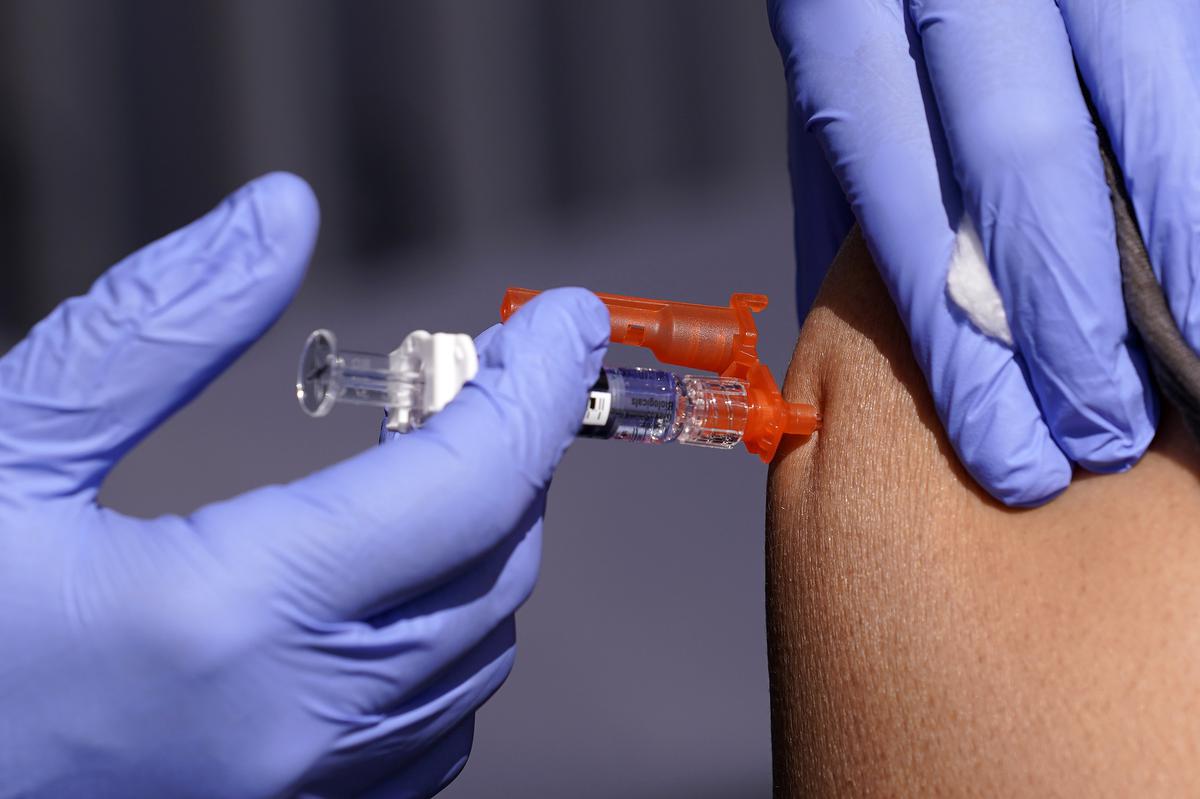One step closer to a universal flu vaccine: what a new study says?

One step closer to a universal flu vaccine: what a new study says? The vaccine would protect against serious illness and death from potential pandemic threats, but it would not replace annual flu shots.
Imagine receiving a single dose of the so-called universal flu vaccine, which researchers have been working on for decades, and your body is prepared to fight every strain of influenza known to man.
According to a recent study, successful animal tests of this vaccine have given rise to hope that the country will be protected from future flu pandemics. The experimental flu vaccine, like the COVID vaccines produced by Pfizer-BioNTech and Moderna, is mRNA-dependent.
Even though it is still in its current early stages and also has only been tested on mice and ferrets, the vaccine provides significant evidence that a single shot could combat an entire family of viruses. If the vaccine is effective in protecting people, the strategy could be extended to other virus families, including the coronavirus.
The vaccine would protect against serious illness and also death from potential pandemic threats, but it would not replace annual flu shots.
According to Scott Hensley, an current University of Pennsylvania immunologist who oversaw the study, there is a real need for the new influenza vaccines to defend against current pandemic threats.
“We might not have had to shut everything down if we had a good vaccine like this that was widely used before the pandemic,” he said. “If a new influenza pandemic breaks out tomorrow.” He and all his colleagues described the current vaccine in the journal Science last week.
By the age of five, most children have had multiple flu infections and have developed some immunity, but only to the strains they have already encountered.
“Our early exposures to influenza lay down long-lasting immune memory that can be also recalled later in life,” says Hensley. However, the author claims that “we’re kind of living the rest of our lives dependent on the new random chance of whatever we got infected with as kids.”
A new strain that could become a pandemic threat is not well protected by the seasonal flu vaccines currently available. During the current 2009 H1N1 swine flu pandemic, for example, the main conventional vaccine provided limited protection against the virus. On the other hand, older adults who grew up with H1N1 strains only had minor symptoms.

Researchers have been working for years to develop a vaccine that would expose children to every strain of flu they might encounter in the future. However, the flu virus’s complexity and technical barriers have limited research.
There are 20 influenza subgroups, each with thousands of viruses. Current vaccines can only target four subgroups at a time. The experimental vaccine, on the other hand, could be produced more quickly and contain all 20.
According to the researchers, the vaccine produced high levels of antibodies to each of the 20 flu subtypes in ferrets and mice. According to several experts, this result was both unexpected and encouraging.
If the vaccine behaves similarly in humans, “we’ll have a more broad coverage of current influenza viruses — not only those that are mainly circulating, but those too that might spill over from the animal reservoir and cause the next pandemic,” says Alyson Kelvin, a vaccinologist at the main University of Saskatchewan in Canada.
One disadvantage of combining 20 targets into one vaccine is that antibody levels in test animals were lower than when they received vaccines targeting specific strains. However, the levels were adequate to combat influenza.
The experimental vaccine’s 20 targets were tested against viruses that were not perfectly matched because a new pandemic strain of influenza could differ from them. The vaccine continued to provide strong protection, indicating that it would likely prevent at least serious illness from a new pandemic flu virus, if not infection.
This phenomenon is analogous to the current COVID vaccines: even though the most recent omicron variants are so dissimilar to the ancestral virus that the original vaccine no longer prevents infections, it still protects the vast majority of people from a severe illness.
Kelvin believes this feature may be a distinct advantage of mRNA vaccines. Traditional flu vaccines are only effective against the viruses for which they were designed. mRNA vaccines, on the other hand, appear to generate antibodies that protect the body from a broader range of viruses than those listed.
Before the vaccine is considered a strong candidate, experts raised a few critical concerns and questions.
The animals in the study developed equal defences against all 20 flu strains. However, Richard J. Webby, an influenza virus specialist at St. Jude Children’s Research Hospital in Memphis, Tennessee, claimed that “these animals have never seen flu before.”
According to Webby, the only people with a complete lack of immunity to the flu are very young children. It needs to be clarified whether older people’s immune responses to a main universal vaccine would be as consistent because they are exposed to many different strains throughout their lives.
“The proof of the new pudding will be what happens in humans and also how going into a great preimmune population skews the current response to it,” Webby said.
Developing universal vaccines for different age groups would be difficult if necessary. Some experts argued that determining how long such a vaccine’s protection would last would be critical.

“The biggest issue with universal flu is figuring out what you need to target and also how long you can mainly keep using the same vaccine,” says Ted Ross, director of the Global Vaccine Development at the Cleveland Clinic. “If you have to keep updating it, the benefit of how we administer vaccines now may not be increased.”
The vaccine would then be tested on monkeys and humans. However, proving its effectiveness may take a lot of work. How can the efficacy of a vaccine be assessed and controlled when its intended targets are not in circulation? Kelvin stated.
She stated: “These are the questions I believe we must address before the next pandemic. The vaccine could be mainly tested in small, sporadic outbreaks or in poultry workers at risk of mainly contracting an avian flu virus.”
The number of new coronavirus cases in China has surpassed 30,000, setting a new 24-hour record. According to the current South China Morning Post, China’s National Health Commission reported 31,444 confirmed a new infections on Thursday morning, breaking all the previous record set in the middle of April.
Germany also reported more than 30,000 cases per day until a few days ago; now, the US and France say higher daily numbers. On the other hand, China is unique because of the rigorous containment strategy it has implemented with varying degrees of success. The last time such high numbers were also reported from China was in March and April this year, when the country saw 1,000 cases in a single day for the first time.
A recent outbreak of infections occurred just days after China relaxed its zero-Covid policy. Only the close contacts of an infected person were quarantined, rather than all of them, and also the quarantine period was reduced to five days, including for international visitors.
As a result of the surge, Zhengzhou, the provincial capital of Henan, went into a five-day lockdown on Friday. The Covid regulations have been also cited as one of the major causes of the city’s main recent widespread protests by Apple factory employees.
A flawed zero-Covid strategy
China has also pursued a zero-Covid strategy from the beginning, whereas most countries have focused on preventing infections from spreading while allowing everyday activities to continue.
Even asymptomatic cases were required to be hospitalised; small outbreaks resulted in strict lockdowns; and also suspected cases, along with all main contacts, were kept in isolation for an extended period. Shanghai, the world’s largest financial centre, is home to more than 25 million people and was completely shut down in March.
The strategy was painful, but it was primarily practical. According to Our World in Data, only over 1.38 million people in China have been recently identified as infected since the pandemic’s start date in 2020. During its worst days, the United States reported similar figures in a single day.
However, this success is now proving to be a liability. Because most people in China have not been exposed to the virus, they lack immunity. Vaccines do not appear to reduce the risk of infection significantly.
As a result, when a very fast-moving variant like Omicron manages to overcome the formidable defences of the zero-Covid strategy, it occasionally encounters a sizable population of vulnerable individuals. The virus can then spread very quickly. This happened in March and April, and it appears that it is still happening today.

Vaccination complications
The same thing also happened in South Korea and Hong Kong in February. Until then, those countries had also managed to keep their population’s virus-free thanks to aggressive testing in South Korea and Hong Kong’s zero-Covid policy. However, when Omicron made a breakthrough, both nations saw tens of thousands of cases and daily fatalities.
China is in similar danger for the second time this year. Omicron causes a milder illness than Delta or Beta but can still kill the elderly. Despite administering nearly 3.5 billion injecting doses, China’s elderly population received relatively few. The effectiveness of two Chinese vaccines currently in use, Sinovac and Sinopharm, has also been called into question.
China was able to control the situation about a month and a half earlier this year. Nothing suggests that the current surge will be significantly different in the future. The most recent wave has exposed the flaws of the zero-Covid strategy, but it also raises the possibility of a return to the stricter regime that the country had just begun to loosen.




